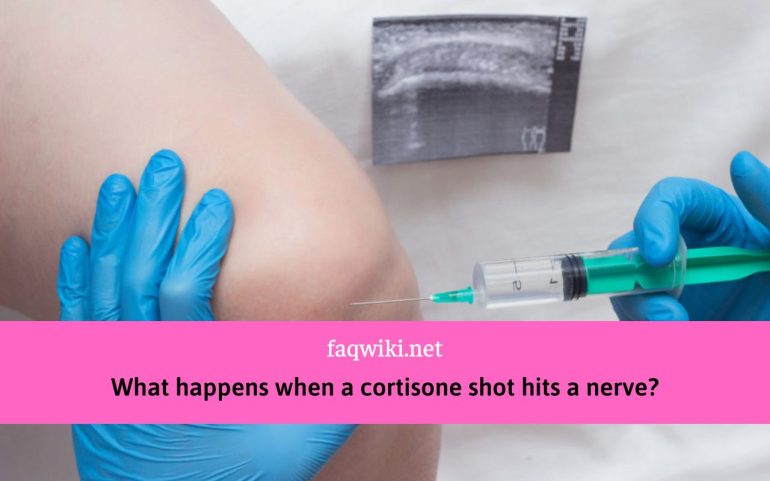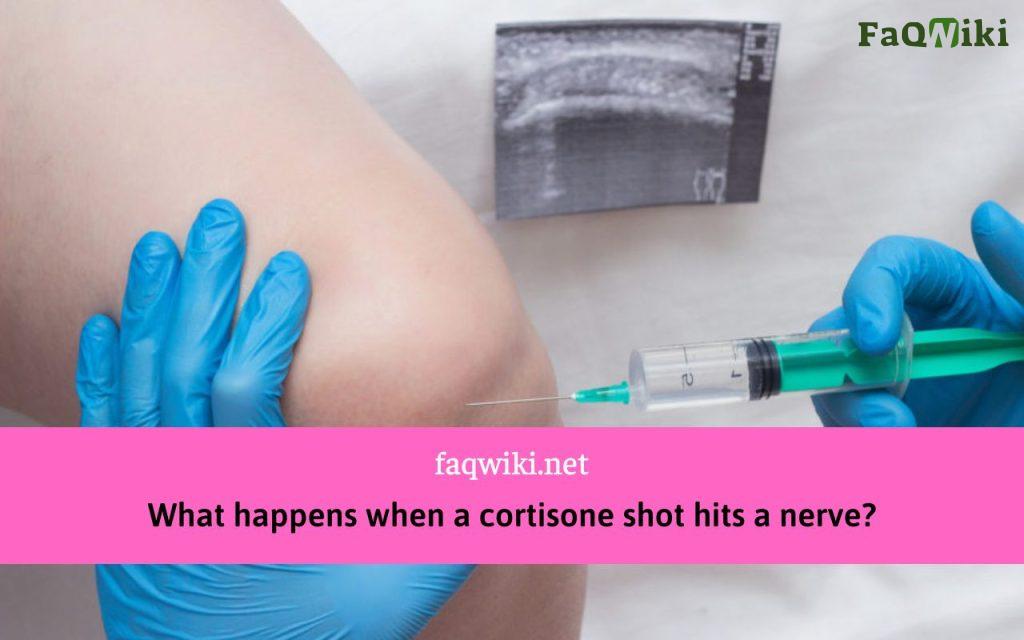What happens when a cortisone shot hits a nerve?

What happens when a cortisone shot hits a nerve? Cortisone shots, also known as corticosteroid injections, are commonly used to treat a variety of medical conditions, including inflammation, joint pain, and arthritis. These injections contain a powerful anti-inflammatory medication called cortisone, which is injected directly into the affected area. While cortisone shots can be an effective treatment option, there are risks associated with the procedure. One of the most serious risks is nerve damage.
Nerve damage from a cortisone shot can occur if the needle hits a nerve during the injection process. Nerves are delicate structures that can be easily damaged, and any damage can result in a variety of symptoms, including pain, numbness, tingling, and weakness. In this article, we will discuss the mechanisms of cortisone shots, the nervous system and nerve damage, the effects of cortisone shots hitting a nerve, diagnosing and treating nerve damage, preventing nerve damage, and legal and ethical considerations.
Understanding Cortisone Shots
Cortisone shots contain a synthetic form of cortisol, a hormone naturally produced by the body’s adrenal glands. Cortisol is involved in the body’s stress response and helps regulate inflammation. When injected into the body, cortisone can reduce inflammation in the targeted area, providing relief from pain and discomfort.
Cortisone shots are commonly used to treat conditions such as osteoarthritis, rheumatoid arthritis, tendinitis, and bursitis. The injections can be administered directly into the joint, tendon, or bursa, depending on the location of the inflammation. The frequency and dosage of cortisone shots vary depending on the condition being treated and the patient’s individual needs.
Despite the benefits of cortisone shots, there are risks associated with the procedure. One of the most serious risks is nerve damage, which can occur if the needle hits a nerve during the injection process.
The Nervous System and Nerve Damage
The nervous system is a complex network of structures that includes the brain, spinal cord, and nerves. The nervous system is responsible for controlling and coordinating all the body’s functions, including movement, sensation, and thinking. The nerves are the structures that transmit information between the brain, spinal cord, and the rest of the body.
Nerve damage can occur due to a variety of factors, including trauma, disease, and medication. When a nerve is damaged, it can result in a range of symptoms, including pain, numbness, tingling, and weakness. Nerve damage can be temporary or permanent, depending on the severity and cause of the damage.
What Happens When a Cortisone Shot Hits a Nerve?
When a cortisone shot hits a nerve, the needle can damage the nerve, causing a range of symptoms. The symptoms can vary depending on the location and severity of the nerve damage.
Immediate symptoms of nerve damage from a cortisone shot can include pain, numbness, tingling, and weakness in the affected area. These symptoms may be accompanied by a burning or prickling sensation. In some cases, the patient may experience a loss of sensation or movement in the affected area.
Long-term effects of nerve damage from a cortisone shot can include chronic pain, loss of function, and decreased quality of life. The severity of the long-term effects depends on the extent of the nerve damage and the patient’s overall health.
Risk factors that increase the likelihood of nerve damage from a cortisone shot include the size and location of the nerve, the technique used during the injection, and the experience of the healthcare provider administering the injection.
Diagnosing and Treating Nerve Damage

What happens when a cortisone shot hits a nerve?
If a patient experiences symptoms of nerve damage after a cortisone shot, it is important to seek medical attention right away. The healthcare provider will conduct a physical exam and may order diagnostic tests, such as nerve conduction studies, to determine the extent of the nerve damage.
Treatment for nerve damage from a cortisone shot will depend on the severity and location of the damage. In some cases, the nerve may heal on its own with time and rest. However, more severe cases may require medication, physical therapy, or surgery to repair the damage.
Preventing Nerve Damage
Preventing nerve damage from a cortisone shot requires careful attention to the injection process. Healthcare providers should take measures to avoid hitting nerves during the injection, such as using imaging technology to guide the needle placement. It is also important to ensure that the healthcare provider administering the injection has sufficient training and experience to perform the procedure safely.
Legal and Ethical Considerations
Nerve damage from a cortisone shot can have serious consequences for the patient, both physically and emotionally. In some cases, the patient may be eligible to pursue legal action against the healthcare provider or facility responsible for the injury. However, it is important to note that pursuing legal action can be a complex and lengthy process, and patients should seek the guidance of a qualified attorney.
From an ethical standpoint, healthcare providers have a duty to provide safe and effective treatment to their patients. If a healthcare provider fails to meet this duty, they may be considered negligent and may be held liable for any resulting injuries.
Conclusion
Cortisone shots can be an effective treatment option for a variety of medical conditions. However, the risk of nerve damage from a cortisone shot is a serious concern. Patients should be aware of the potential risks and benefits of the procedure and should seek medical attention right away if they experience any symptoms of nerve damage.
Healthcare providers should take all necessary precautions to prevent nerve damage during the injection process, including using imaging technology to guide needle placement and ensuring that they have sufficient training and experience to perform the procedure safely.
By understanding the mechanisms of cortisone shots and the potential risks associated with the procedure, patients and healthcare providers can work together to ensure safe and effective treatment outcomes.
FAQs
What are cortisone shots used for?
Cortisone shots are commonly used to treat conditions such as osteoarthritis, rheumatoid arthritis, tendinitis, and bursitis.
What are the risks associated with cortisone shots?
One of the most serious risks associated with cortisone shots is nerve damage, which can occur if the needle hits a nerve during the injection process.
What are the symptoms of nerve damage from a cortisone shot?
Symptoms of nerve damage from a cortisone shot can include pain, numbness, tingling, and weakness in the affected area.
Can nerve damage from a cortisone shot be treated?
Treatment for nerve damage from a cortisone shot will depend on the severity and location of the damage. In some cases, the nerve may heal on its own with time and rest. However, more severe cases may require medication, physical therapy, or surgery to repair the damage.
How can nerve damage from a cortisone shot be prevented?
Preventing nerve damage from a cortisone shot requires careful attention to the injection process. Healthcare providers should take measures to avoid hitting nerves during the injection, such as using imaging technology to guide the needle placement.
